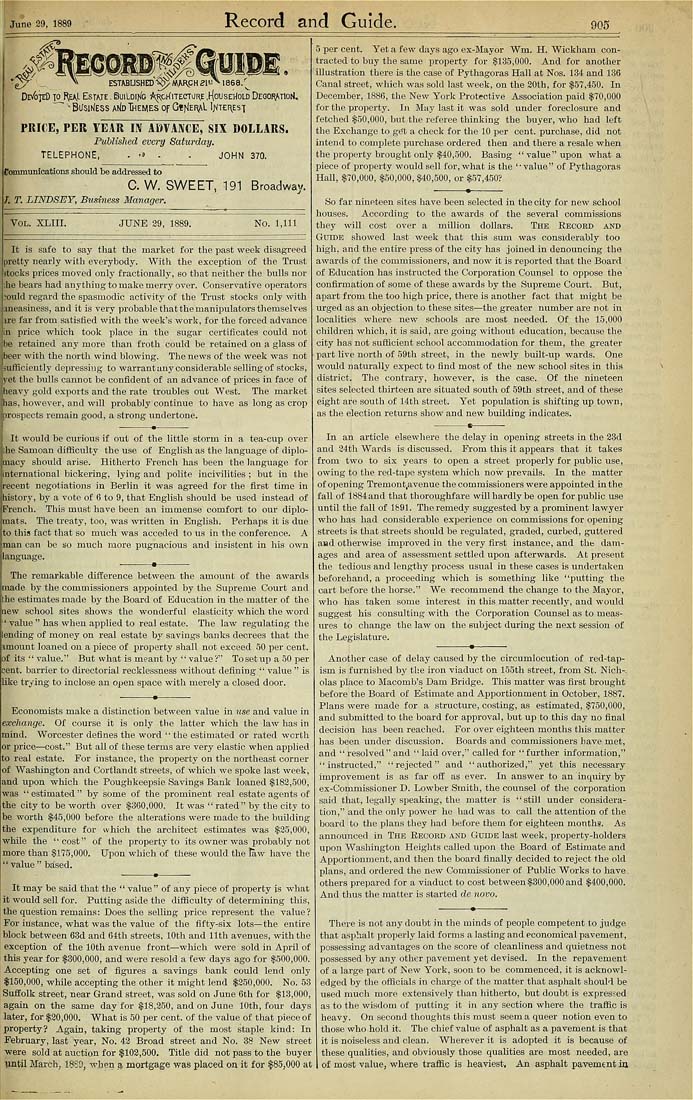Columbia University Libraries Digital Collections: The Real Estate Record
Use your browser's Print function to print these pages.
Real estate record and builders' guide: v. 43, no. 1111: June 29, 1889

Text version:
Please note: this text may be incomplete. For more information about this OCR, view About OCR text.
June 39, 1889 Record and Guide. 905 ^Jy - ^ E5TABUSHED-^WAHCH2I'-i* 1868.'^ De/oJeD TO_HeA,L EsrWE, BuiLolf/C AfICHiTECTJI^E .HoUSElfOLD DEGOf^AHOtJ. - BiisiflEss AfJo Themes op CtfJErtftl- 1;^tei\es^ PRICE, PER YEiR IIV ADVANCE, SIX DOLLARS. Published every Saturday. TELEPHONE, . ■* . . jqhn 370. Commuulcations should be addressed to C. W. SWEET, T91 Broadway. K T. LINDSEY, Business Manager. Vol. XLIII. JUNE 29, 1889. No. 1,111 It is safe to say that the market for the past week disagreed pretty nearly with everybody. Wifcli tlie exception of the Trust jtocks prices moved only fractionally, so that neither the bulls nor ;he bears had anything to make merry over. Conservative operators :oiild regard the spasmodic activity of the Trnst stocks only with aneaeiness, and it is very probable that the raaniimlators themselves ire far from satisfied with the week's work, for the forced advance in price which took place in the sugar certificates could not be retained any more than froth couid be retained ou a glass of beer with the north wind blowing. The news of the week was nofc iuiBcieiitly depressing to warrant any considerable selling of stocks, j-et the bulls cannot be confident of an advance of prices in fa'ie of heavy gold exports and the rate troubles out West. The market fias, however, and will probably continue to ]iave as long as crop arospects remain good, a strong undertone. It would be curious if out of the little storm in a tea-cup over ihe Samoan difficulty the use of English as the language of diplo- nacy should arise. Hitherto French has been the language for nternatioaal bickering, lying and polite incivilities ; bufc in fche recent negotiations in Berlin it was agreed for the first time in bistory, by a vote of 6 to 9, that English should be used instead of French. This must have been an immense comfort to our diplo¬ mats. The treaty, too, was written in English, Perhaps it is due to this fact that so much was acceded to us in the conference. A man can be so mnch more pugnacious and insistent in his owu language. ---------•--------- The remarkable difference between the amount of the awards made by the commissioners appointed by the Supreme Court aud the estimates made by the Boai-d of Education iu the matter of the aew school sites shows tlie wonderful elasticity which the word ' value " has when applied to real estate. The law regulating the lending of money on real estate by savings banks decrees that the imount loaned on a piece of property shall not exceed 50 per cent, af its •' value." But what is meant by '■ vaLie?" To set up a 50 per :ent, barrier to directorial recklessness without defining " value " is tike trying to inclose an open space with merely a closed door. Economists make a distinction between value in use aud value in exchange. Of course it is only the latter which the law has in mind. Worcester defines the word '■ the estimated or rated worth or price—cost." But all of these terms are very elastic when applied to real estate. For instance, the property on the northeast corner of Washington and Cortlandt streefcs, of which we spoke last week, and upon which the Poughkeepsie Savings Bauk loaned §183,500, was "estimated" by some of the prominent real esfcate agents of the city to be worth over $360,000. It was '' rated " by the city to be worth $45,000 before the alterations were made to the buildiug the expenditure for which the architect estimates was $95,000, while the "cost" of the property to its owner was probably not more fchan §175,000. Upon which of these would the law have the "value" based. It may be said that the " value" of any piece of property is what it would sell for. Putting aside the difficulty of determining tliis, the question remaius: Does the selling price represent the value? For instance, what was the value of the fifty-six lots—the entire block between 63d and 64fcli streets, 10th and llth avenues, with the exception of the IOth avenue front—which were sold in April of this year for $300,000, and were resold a few days ago for i(;500,000. Accepting one set of figures a savings bank could lend only $150,000^ while accepting the other it might lend $250,000. No. 53 SuSolk street, near Grand street, was sold on June Gth for i§13,000, again on the same day for $18,250, and on June 10th, four days later, for $30,000. What is 50 per cent, of the value of tliat piece of property? Again, taking property of the most staple kind: In February, last year. No. 42 Broad street and No. 38 New street were sold at auction for $108,500. Title did nofc pass to the buyer )iutjl March, 1889, when 3, mortgage was placed on it for $85,000 at 5 per cent. Yet a few days ago ex-Mayor Wm. H. Wickham con¬ tracted to buy the same property for §135,000. And for another illustration there is the case of Pythagoras Hall at Nos. 134 and 136 Canal streefc, which was sold last week, on the SOth, for $57,450. In December, 1886, the New York Protective Association paid $70,000 for the property. In May last it was sold under foreclosure and fetched $50,000, but the referee thinking the buyer, who had left the Exchange to g